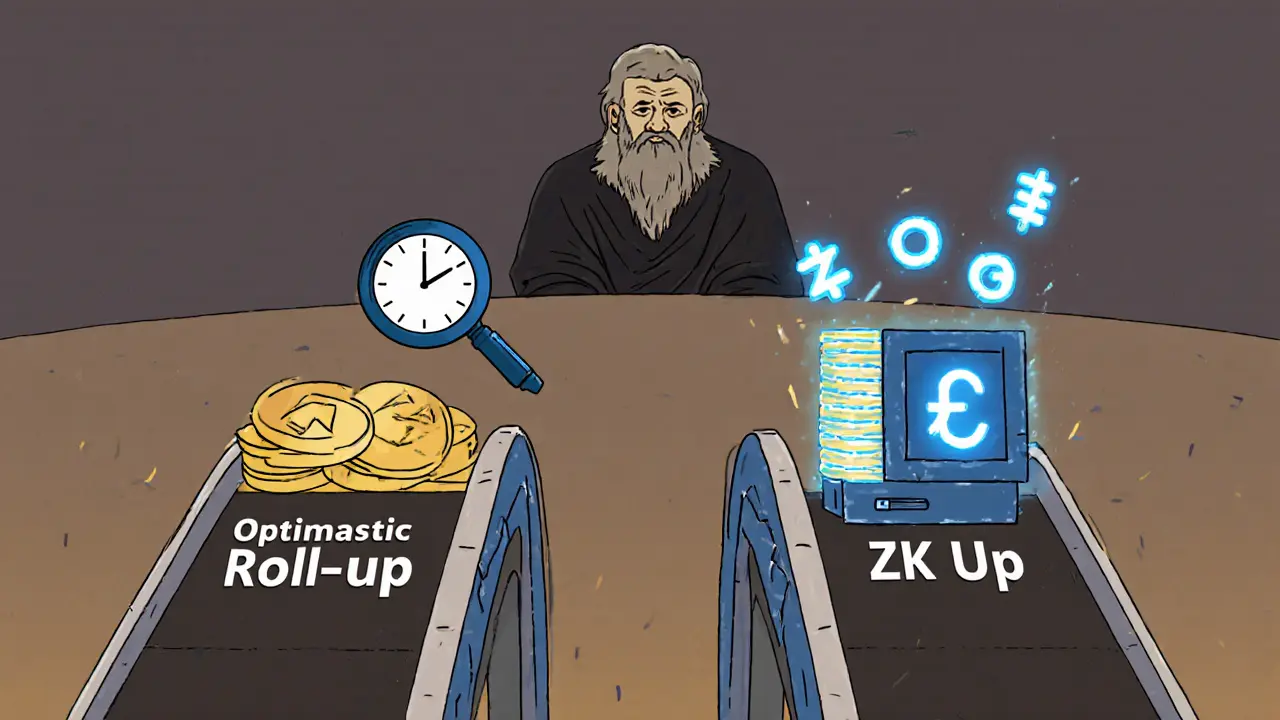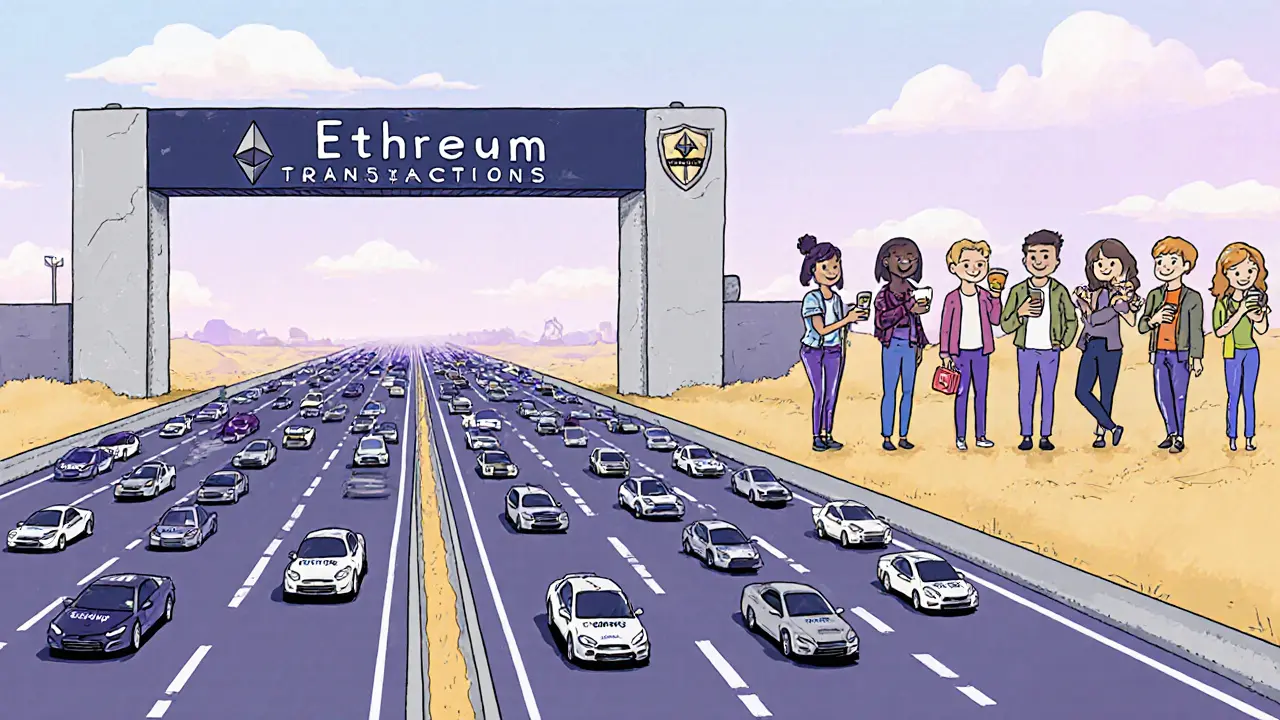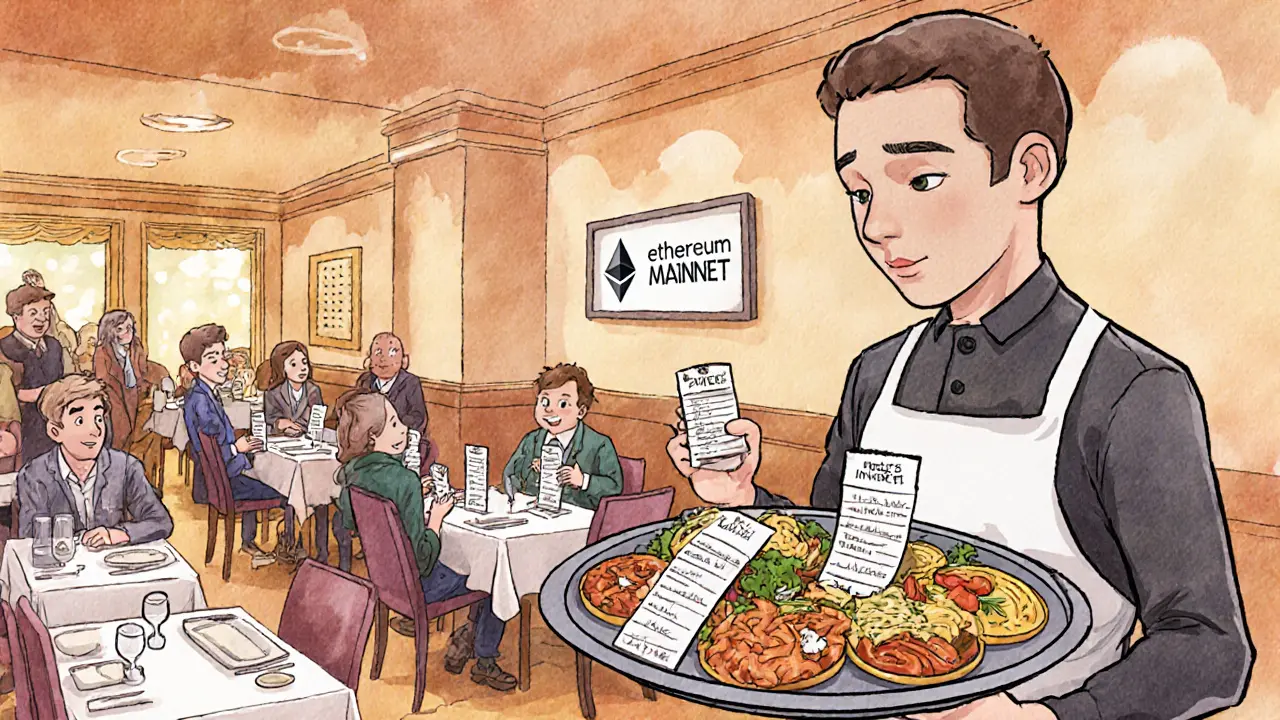Ethereum Transaction Cost Calculator
Ethereum Mainnet
Average cost: $12.50 per transaction
$0.00 total
Rollup Network
Average cost: $0.10 per transaction
$0.00 total
Right now, Ethereum can only handle about 15 to 20 transactions per second. That’s less than what a single Visa card can process in a single second. When demand spikes-like during an NFT drop or a DeFi surge-gas fees spike too. People have paid over $100 just to send a simple ETH transfer. That’s not a blockchain for the masses. That’s a bottleneck.
Enter rollups. They’re not magic. They’re not a new blockchain. They’re a clever trick that lets Ethereum do more without changing its core rules. Rollups take hundreds of transactions, bundle them up, and process them off-chain. Then they send just a tiny cryptographic summary back to Ethereum. The main chain doesn’t care about the details. It only checks: Is this batch valid? If yes, it locks in the results. That’s it.
How Rollups Actually Work (No Jargon)
Think of rollups like a group order at a restaurant. Instead of each person ordering one dish and waiting for the waiter to come back 10 times, you all write your orders on one slip. The kitchen makes everything at once. Then the waiter brings back one tray with all the food. That’s faster, cheaper, and less chaotic.
On Ethereum, rollups do the same thing. They collect dozens or even hundreds of transactions-swaps, NFT mints, token transfers-and run them on a separate chain that’s linked to Ethereum. This chain isn’t independent. It doesn’t have its own security. It leans entirely on Ethereum to verify everything. Once the batch is done, it sends one of two things back to Ethereum:
- A fraud proof (for Optimistic Rollups)
- A zero-knowledge proof (for ZK Rollups)
These aren’t just buzzwords. They’re the two different ways rollups prove the batch is correct without re-running every single transaction on Ethereum.
Optimistic vs. ZK Rollups: What’s the Difference?
There are two main flavors of rollups. Each has trade-offs.
Optimistic Rollups assume everything is fine by default. They don’t prove anything right away. Instead, they say: “Here’s the result. If you think it’s wrong, challenge it within 7 days.” During that window, anyone can submit a fraud proof to show a transaction was faked. If they’re right, the bad actor loses their stake. This system works because Ethereum’s security makes cheating too expensive. But you have to wait up to a week to withdraw your funds if you’re using an Optimistic Rollup. That’s the price of simpler tech.
ZK Rollups do the opposite. They prove everything is correct before it even hits Ethereum. They use math called zero-knowledge proofs-complex cryptographic tricks that show a batch of transactions is valid without revealing any details. It’s like proving you know a secret password without saying the password. ZK rollups don’t need a waiting period. Withdrawals are instant. They’re also more efficient with data, meaning they can fit even more transactions into each batch.
But ZK rollups are harder to build. Generating those proofs needs serious computing power. That means fewer teams can run them. Optimistic rollups are easier to deploy, which is why they came first and still have more users today.
How Much Faster and Cheaper Are They?
Ethereum’s mainnet does 15-20 TPS. That’s barely enough for a small city.
Rollups? They can hit 1,000 to 4,000 TPS-and that’s just the start. Some optimized rollups have tested over 10,000 TPS in labs. The real win isn’t just speed. It’s cost.
On Ethereum mainnet, a simple ETH transfer can cost $5-$20 during peak times. On a rollup? It’s often under $0.10. Some DeFi swaps cost less than a penny. That’s not an improvement. That’s a revolution.
And it’s not theoretical. Projects like Arbitrum (Optimistic) and zkSync (ZK) are already handling millions of transactions daily. Users aren’t just testing them-they’re living on them. DeFi apps, NFT marketplaces, and even games are moving entire operations off Ethereum mainnet and onto rollups.

Why Rollups Beat Other Scaling Ideas
People have tried other ways to scale Ethereum:
- Sidechains like Polygon have their own blockchains and security. They’re fast and cheap-but if the sidechain gets hacked, your money is gone. Ethereum doesn’t protect you.
- State channels like the Lightning Network work great for two people sending money back and forth. But they don’t scale for apps with hundreds of users interacting at once.
Rollups fix both problems. They don’t create new security models. They don’t leave Ethereum behind. They use Ethereum as the ultimate judge. If something goes wrong, Ethereum steps in. That’s why rollups are called “Layer 2”-they sit on top of Layer 1, not beside it.
And because rollups are EVM-compatible, most Ethereum smart contracts work on them without changes. Developers didn’t have to rewrite everything. They just moved their apps to a faster lane.
The Big Picture: Rollups + Ethereum 2.0
The Merge in 2022 didn’t just make Ethereum greener. It laid the groundwork for rollups to explode. Before the Merge, Ethereum couldn’t handle much data. Rollups needed to compress everything into tiny blobs. Now, with Ethereum’s new data availability layer, rollups can post way more data per block.
That’s where sharding comes in. Ethereum plans to split its data storage into 64 shards-like 64 parallel highways. Each shard can store rollup data. That means rollups can process even more transactions without competing for space.
Put it all together: rollups handle the work. Ethereum handles the security. Sharding gives them room to breathe. The result? A path to 100,000 transactions per second. That’s not a dream. It’s the roadmap.

Who’s Using Rollups Today?
You don’t need to wait for the future. It’s already here.
- Arbitrum and Optimism are the biggest Optimistic Rollups. They host top DeFi apps like Uniswap and Aave.
- zkSync Era and Starknet lead in ZK rollups. They’re popular for trading, gaming, and private transactions.
- Base, built by Coinbase, runs on Optimism’s stack. It’s become one of the fastest-growing chains for new users.
These aren’t side projects. They’re the main networks people use now. Over 60% of Ethereum’s daily active addresses are on rollups, not mainnet. That’s the real metric: adoption.
What’s Next for Rollups?
Rollups aren’t done evolving. Here’s what’s coming:
- Cross-rollup communication: Right now, moving assets between Arbitrum and zkSync requires going through Ethereum. Soon, you’ll be able to move directly between rollups-faster and cheaper.
- Proof compression: ZK proofs are getting smaller. That means less data to post on Ethereum, which lowers costs even more.
- Modular rollups: Developers will be able to pick and choose components-like a custom virtual machine or a specific proof system-instead of being locked into one setup.
The goal isn’t just to make Ethereum faster. It’s to make it usable. For everyone. Not just speculators. Not just developers. Regular people buying coffee with crypto, sending money to family overseas, or playing a game without paying $5 in fees just to mint a skin.
Rollups aren’t the end of Ethereum’s scaling journey. But they’re the first real solution that doesn’t sacrifice security for speed. And that’s why they’re the only scaling path that matters.
Are rollups safe?
Yes, but it depends on the type. Optimistic rollups rely on Ethereum’s security and a 7-day challenge window to catch fraud. ZK rollups use cryptographic proofs that are mathematically verifiable on Ethereum before anything is finalized. Both are far safer than sidechains or independent blockchains because they inherit Ethereum’s decentralization and attack resistance.
Do I need to use a rollup?
No, but if you’re using Ethereum for anything beyond simple transfers, you should. Gas fees on mainnet are still high for most use cases. Rollups reduce costs by 90-99%. Most DeFi apps, NFT platforms, and Web3 games now run on rollups. Staying on Ethereum mainnet means paying more and waiting longer for no real benefit.
Can I still use Ethereum wallets like MetaMask with rollups?
Yes. MetaMask and other wallets automatically detect rollup networks. You just need to add the network (like Arbitrum One or zkSync Era) as a custom RPC. Once added, you can send ETH or tokens to your rollup address. You’ll see your balance update instantly. The wallet handles the bridge for you.
Why not just use another blockchain like Solana?
Solana and other chains are faster and cheaper, but they’re not secured by Ethereum. If Solana goes down, your assets are stuck. Ethereum rollups keep your assets anchored to the most secure, decentralized blockchain in crypto. You get speed without giving up trust. That’s why developers and institutions prefer rollups over alternatives.
Will rollups make Ethereum mainnet obsolete?
No. Ethereum mainnet becomes the security layer. It’s where rollups post their proofs and where final settlement happens. You’ll still need ETH to pay for posting data to mainnet, but the cost per transaction is tiny. Mainnet won’t disappear-it’ll become the foundation. Rollups become the workhorses. It’s a division of labor, not a replacement.

I just used Arbitrum to swap some tokens and paid 3 cents in gas. Like, I literally bought coffee with crypto this morning and didn't cry afterward. This is what Web3 was supposed to be.
I really appreciate how this post breaks down rollups without drowning us in jargon... it's so rare to find something that respects the reader's intelligence, and also doesn't assume we already know what a zk-SNARK is. Thank you for writing this with such clarity and care.
man i been on zksync for months now and its crazy how smooth it is like i dont even think about gas anymore and the nfts load faster than my phone gallery lol i wish more people knew this was real
Let me stop you right there. You're oversimplifying. Optimistic rollups aren't 'safe'-they're trusting a 7-day window that could be gamed by a coordinated attack. And ZK rollups? They're computationally expensive because the math is still in its infancy. We're not at 'revolution' yet-we're at 'experimental phase with hype'. Don't mistake adoption for security.
This is why crypto is a scam. Everyone's acting like rollups are magic when they're just centralized servers pretending to be decentralized. You think your 'cheap gas' is safe? It's all controlled by a handful of devs. Wake up.
The ontological underpinning of rollup architecture reveals a profound epistemic shift in blockchain governance: the delegation of computational burden while preserving cryptographic verifiability. This isn't scaling-it's reconstituting trust topology via layered proof systems that externalize consensus costs while internalizing semantic integrity.
I mean... I get it. Rollups are cool. But like... isn't it weird that we're just putting bandaids on Ethereum instead of fixing the root problem? Like why not just build something new? Why do we keep clinging to this old thing like it's our first love? I'm just saying...
This is the moment 😍 I remember when ETH gas was $100 and now I'm trading NFTs for less than a coffee. Thank you for explaining this so clearly. We’re living in the future.
You guys are being manipulated. Rollups are a Trojan horse. The real goal is to make you dependent on centralized sequencers. They're logging everything. Your wallet activity? Monitored. Your swaps? Tracked. Ethereum is becoming a surveillance layer. Don't be fooled by 'cheap fees'-they're paying for your privacy.
I live in South Africa and the fees on mainnet were killing me. Now I use zkSync and I can send money to my family without thinking twice. This isnt just tech its life changing
The real win isn't speed or cost-it's composability. Now apps can talk to each other without drowning in gas. That's the quiet revolution. Nobody talks about it but DeFi is finally starting to feel like a real ecosystem, not a bunch of broken toys.
Rollups? More like roll-ups. Like a bad burrito. You think you're getting value but it's just wrapped in hype. Solana’s faster, cheaper, and doesn't need a 7 day wait. Stop pretending Ethereum is special.
They're hiding the truth. The sequencers are all controlled by the same VC firms. Your 'decentralized' rollup is just a front. They're building a new Wall Street on top of Ethereum. You're not winning-you're being groomed.
I love how people act like rollups are new. They’ve been in beta for 3 years. And guess what? Most of the 'users' are bots. I've seen the data. The real people? Still on mainnet because they don't trust these sidechains.
One thing people overlook: ZK rollups are making private transactions possible without sacrificing decentralization. That’s huge for financial privacy. This isn’t just about fees-it’s about dignity. You deserve to transact without being tracked.
I'm sorry but if you're using a rollup, you're already compromised. Ethereum mainnet is the only real chain. Everything else is a glorified sidechain with a fancy name. You're giving up sovereignty for convenience. And that's not progress-it's surrender.
If you're still paying $10 to send ETH, you're doing it wrong. Rollups aren't optional anymore-they're the default. I helped my mom set up MetaMask with Arbitrum last week. She sent $20 to her sister in Mexico. No drama. No stress. Just worked. That's the future.
Everyone's so excited about rollups, but no one talks about how they're making Ethereum even more energy-intensive. The data blobs on mainnet? They're huge. You're not saving the planet-you're just hiding the cost.
i used to think zksync was for geeks but now i use it daily and its like night and day compared to mainnet. also the devs are super chill and respond to issues fast. real talk
Best upgrade ever. No more gas panic. Just send and forget. 😊